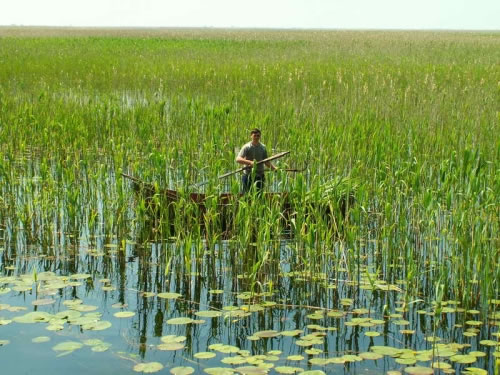Jun
30
Oil Spill?: Delta Bulrush to the Rescue
It seems that the Obama administration is finally accepting aid from other countries in dealing with the BP oil disaster in the Gulf of Mexico. ‘Bout freakin’ time! Booms, skimmers, sweeping arms, whatever — we need ’em!
Scientists of various disciplines have been doing their part, official or otherwise, to devise and recommend ways to seal the “leak” and to clean up and restore the local flora & fauna as much as possible. From physicists and engineers to marine biologists and biochemists — lots of ideas, only a very few get tried. Sometimes something goes wrong, or it doesn’t work as well as was hoped. Well, at least it’s something. (If things had been better managed from the start,….) Now, a revered botanist is pitching an idea to, well, anyone who will listen.
Dr. Alfred Ernest Schuyler, curator emeritus of botany for the Academy of Natural Sciences, thinks he may be onto something that could greatly reduce the impact of the “spill” — at least, in the Mississippi Delta. Forty years ago, Dr. Schuyler was the first to profile and name the delta bulrush (Schoenoplectus deltarum), a reedy plant of the sedge (Cyperaceae) family. Now, Dr. Schuyler is strongly encouraging those in charge of clean-up efforts in the Gulf to study the bulrush’s unusual properties.
For one, bulrushes in general are known to be rather resistant to oil — moreso than many other marsh plants. The delta bulrush is quite plentiful in the Mississippi Delta, and it will be one of the first that the oil will encounter when it hits the area. So, there is good reason to think it will serve as a partial buffer and a stabilizing force for the region’s marshes.
How much is too much even for the bulrush? No one knows for sure, but if the plants become covered, Schuyler recommends harvesting them just below the oil line. “This will protect waterfowl from the oil and also will allow regrowth from their basal portions.” Their seeds can also be removed from the harvested plants and replanted in untainted marshbed.
There is another interesting property of this local resident to consider. Dr. Schuyler explains,
Bulrushes are environmental workhorses, effectively used in sewage lagoons to purify water. Air cavities in the stems transport oxygen to underwater portions of the plants, making the oxygen available to microbes capable of decomposing pollutants in the sewage.”
Moreover, Schuyler believes the delta bulrush should be able to use the same process to break up “some chemicals in the oil, thereby reducing the impact of the spill to the delta area.” (There may even be some evidence for the common three-square, a close relative of the delta bulrush, having done this.)
Sounds very promising. Now, if they can just find a salt-water equivalent….
* The Academy of Natural Sciences. “Delta Bulrush Plant Could Help Ease Oil Spill Crisis, Botanist Says.” ScienceDaily 29 June 2010. 29 June 2010 <http://www.sciencedaily.com/releases/2010/06/100628112111.htm>.















